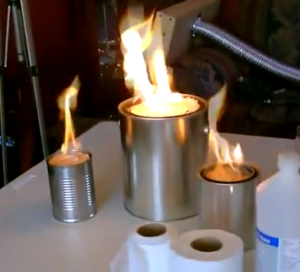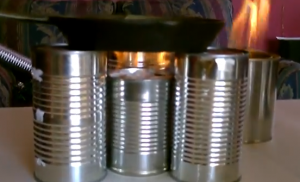 Sure, there are a million survival stoves on the market. But if you’re like me, you’re a huge sucker for learning how to build your survival tools all by yourself, “MacGyver style” as I like to say…
Sure, there are a million survival stoves on the market. But if you’re like me, you’re a huge sucker for learning how to build your survival tools all by yourself, “MacGyver style” as I like to say…
That’s why I was excited to come across this video, which shows how to build a low-tech alcohol stove out of a paint can, rubbing alcohol, and a roll of TP.
In fact, this is an excellent time to add all 3 of these items to you survival checklist:
1 – large tin or aluminum can
1 – Large container of rubbing alcohol (isopropyl alcohol)
1 – Extra roll of toilet paper (you can never really have too much)
Here’s how to build this simple heater/stove:
Step 1:
Remove the label from a 1-quart size paint can or large can of baked beans. Ideally, your can will be large enough to fit your roll of toilet paper inside.
Step 2:
Remove the cardboard cylinder from the center of a toilet paper roll, and cram the paper into the can. This will be your wick.
Step 3:
Pour the alcohol into the can, filling it almost to the brim.
Step 4:
Light her up and enjoy your smokeless, off-the-grid heater. To extinguish, just place the lid back on the can (carefully).
These tin can heaters can be used as stoves, in addition to heaters, by using 3 taller cans to support your pan or skillet. The video illustrates this effect quite well.

But once again, the cool thing about these alcohol heaters are 1) The fact that they don’t create smoke (because they’re burning alcohol instead of coal or oil), 2) They’re quiet, 3) They’re hot enough to heat a small room all by themselves.
Obviously, you’ll need to take some fire safety steps since you’ll be dealing with an open flame. Don’t leave it unattended.


What is the real purpose of the toilet paper? It seems the same affect could be had with only alcohol. And it seems there would be much better heating effect if the can is used as a radiator.
It does not seem to be practical for anything but a bugout type of application.
I can see this in an extreme emergency like if you are stuck some place in your car for instance. These could easily stored and carried safely in the car and put to immediate use without any preparation.
My ISP sent me a warning that there was a problem with security in your ordering website. I would still like to receive your
Report on the 5 trigger steps that preceed an economic collapse.
Hi Otis, I have no idea why your ISP is giving you a warning. We haven’t had any reports of problems with our ordering system. Here’s the link if you’d like to try it in a different browser: https://yo107.infusionsoft.com/go/StrawBanner/house/
Best,
Oli
Thanks for these timely and unique ideas for emergency heat and lighting. With my supervision, I am going to help my 9 year old grandson learn how to .make these items to 1) teach him self reliance; 2) show him how to construct ( with simplicity) items that in an emergency could save his life; 3) demonstrate scientific principles; 4) and finally, help him to build useful and practical items that be can given as gifts throughout the year to his favorite adults. WONDERFUL info., thanks again. LibrTbelle.
The TP acts like a catalyst and is safer in the event of a spill. Additionally it slows the burn cycle, creates a more consistant surface and will allow more burn for amount of alcohol used.
A full quart of burning alcohol will cause a huge area of fire if tipped over. (just a thought)
It appears that the purpose for the toilet paper in the can is to keep the alcohol contained, if can were to be tipped over you would not be spilling a large amount of liquid that would set your home ablaze. good idea, any good prepper has a large quantity of alcohol on hand anyway.
You can also use cardboard cut into 4-6 inch strips and coiled up in the bottom of the can with the little tubes or folds vertical. And a word of caution, be careful you don’t end up with a galvanized can. It will give off toxic fumes when you get it hot.
Hi Oli, I ordered your 1st report and I have yet to receive an email for confirmation, and it’s been approx. 1 1/2 hrs. Also while trying to get the remaining reports and subscribe to The Patriot Caller, I have tried 3 times and have received 3 different error messages. Please help.
Thanks
The site is not secure for ordering with my credit card (https)
Hi John. All of our transaction are done on secure sites, but I do understand your concern.
Hi Debbie, Customer service will follow up with you this morning. In the meantime, you may want to check you “junk” or “spam” folder for your access email. Thanks!
Hi Oli,
I learned this technique years ago using a 1lb coffee can however, finding one now is impossible. Nice to know what other cans fit a roll of TP. Living in Colorado I keep a set up in my car; you never know when or where you could be stranded. Hypothermia is no joke; people don’t realize how quickly you can freeze to death even in a dry climate like ours.
Thanks,
Darleyne
Hello again Oli, I did look in my junk/spam folder and nothing there either.
“1 – large aluminum can”
There is no aluminum restriction per se.
How can you tell if a can is galvanized or not?
You don’t mention the danger of Carbon Monoxide.
Please remember to have good ventilation.
How do you extinguish the flame when you’re done with it? Can you reuse it? And how do know if a can is galvanized?
Hi Pauline, Just put the lid back on the can to extinguish the flame.
the toilet paper serves as a wick for the alcohol thus keeping the flame at the top of the can at all times resulting in a more consistent flame and also serves as a protective device in the event that the can gets turned over. if possible I would recommend obtaining a can combination which has a plastic cover so that the can can be sealed when not in use and the evaporation prevented.
I’ve been reading the ideas for heating with the candles and flower pots and the can with TP and alcohol.
My thought is; the can, TP and alcohol with the flower pots suported above with the same size cans. To my way of thinking, this should work even better!
How can you tell if a can is galvanized or not?
All metal cans that are used to contain fruits & vegetables at your local grocery store are “galvanized”. This means that they are coated with a layer of tin, to prevent them from rusting and contaminating the food. This is not true galvanizing, because the word was invented to mean coating iron, or steel, with zinc.